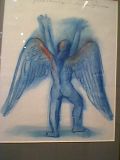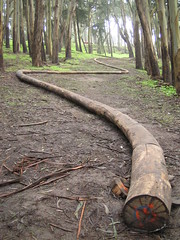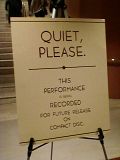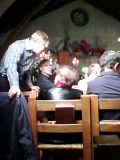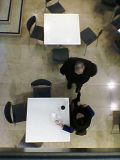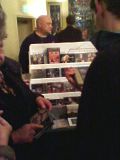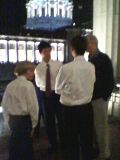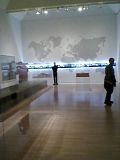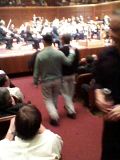
Friday night's screening of
Best of Annecy at the
SF International Film Festival started 10 minutes late, due to a last minute rush of ticket buyers & a cumbersome ticketing process that required each ticket to be printed individually. However, the staff was clearly grateful for the full house. The program was a mixed bag of 7 shorts.
Lebensader (Angela Steffen, Germany 2009, 6 min)
Abstract film in which flat, colorful, totemic images of plants & animals morph into one another.
I Forgive You (Pierre Mousquet, Jérôme Cauwe, Belgium 2009, 5 min)
A deliberately tasteless gag cartoon in which 2 steroidal wrestlers teach a lesson in forgiveness. Pehaps they are a Belgian version of Beavis & Butthead.
Jean-François (Tom Haugomat, Bruno Mangyoku, France 2009, 6 min)
Psychological portrait in which a champion swimmer recalls his lost childhood instead of savoring his victory. The film has a lot of moody imagery but minimal animation. The sound was uncomfortably loud at the screening.
Don’t Go (Turgut Akacik, Turkey 2010, 4 min)
Combines live footage of a frisky cat chasing a small computer-generated character with the body of a pink bunny & a giant eyeball instead of a head. The most unexpected thing about this film is that it comes from Turkey.
Love & Theft (Andreas Hykade, Germany 2009, 7 min)
A series of cartoon faces morph into one another in tight synchronization to pounding music. Some of the faces are monstrous while others, such as those of Charlie Brown, Hello Kitty & Gromit, are benignly banal. The effect is hallucinatory & nightmarish.
Angry Man (Anita Killi, Norway 2009, 20 min)
Earnest story about domestic abuse, aimed at children & enacted by paper puppets. Its depiction of a child's fear of an abusive parent is painfully heavy-handed. The situation is resolved through a personal visit from King Harald of Norway, who appears as a kind of Santa Claus of deliverance. Perhaps this makes sense in a Norwegian context, but I did not get it. The tone is so thoroughly serious that one presumes the story is meant to instruct.
The Lost Thing (Andrew Ruhemann, Shaun Tan, Australia 2010, 16 min)
Shaun Tan's picture book of the same name transferred into computer animation. The whimsical & slightly sinister atmosphere of Tan's work is beautifully preserved in the film's deadpan style. The ambiguous story line has the feel of a parable.
§ San Francisco International Film Festival
Best of Annecy 2010
Friday, November 12, 7:00 pm
Landmark's Embarcadero Center Cinema
 Today's Wall Street Journal asked people in the arts & culture for their new year's resolutions. Local maestro Michael Tilson Thomas shared his goals ranging from test driving the New World Symphony campus to perfecting soup recipes:
Today's Wall Street Journal asked people in the arts & culture for their new year's resolutions. Local maestro Michael Tilson Thomas shared his goals ranging from test driving the New World Symphony campus to perfecting soup recipes: